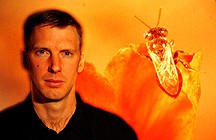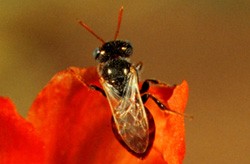To survive their harsh environment, desert bees hedge their bets with a wait-and-wet attitude, Cornell researcher discovers
By Blaine Friedlander
The northern tip of the Chihuahuan Desert juts from northern Mexico into the southern parts of Arizona, New Mexico and Texas. It is where black-tailed jackrabbits scurry, roadrunners sprint and diamondbacks slither. For the continent's largest desert, punctuated by mountains, the monsoon rains end sometime in late summer. Then the flowers bloom, and the desert bees come out. And like the desert's floral seeds waiting for their season in the sun, scientists have learned that the desert bees have adopted a patient reproductive strategy. Desert bee larvae patiently lie in wait in the desert soil for a chance to emerge, usually after a year or more. Scientists call this process "diapause," a bet-hedging strategy that results in the survival of the best-rested.
But according to new research by Cornell entomologist Bryan N. Danforth, not all the viable larvae emerge in any one year of diapause, and their "coming out" is triggered by rain. Writing in the October issue of The Proceedings of the Royal Society of London, Danforth notes that by spreading reproduction over several years, desert bees can keep catastrophic losses of their kin to a minimum in very bad drought years.
"This is evidence of a bet-hedging life history," says Danforth, an assistant professor at Cornell. "The bees are giving up reproduction in year one to reproduce in year two, and this is the first study that shows that rainfall triggers emergence in bees. That the bees have rainfall-induced emergence is remarkable and helps further explain why bees are so diverse in arid regions."
According to Danforth, "This past year was a good year for the bees. As humans we do a lot of bet-hedging, too. We use a bet-hedging strategy when we buy mutual funds for investments. As humans, we learn to spread out our risks all the time. Well, so have plants, and now we learn so have the desert bees."
Bet-hedging also can have ecological effects, in that the sheer variety of pollinating desert bees might be enhanced by such a life history.
"What's remarkable about the results is the similarity between the bees and desert plants under the same conditions," says Danforth. He explains that the seeds of desert annual plants and the overwintering desert bee larvae mature and reproduce over a short period of time following the monsoon rains. Most of the rainfall occurs during July, August and September, with thunderstorms sometimes so dramatic that roads get washed out.
But the rains trigger the flowering and signal the bees to emerge. Like seeds, the bee larvae are buried in the soil, exposed to high temperature and low humidity and subject to attack by foraging ants, fungal pathogens and desiccation.
"That desert doesn't get a lot of rain; it's a pretty harsh environment. What's amazing is that animals -- in this case the bees -- and plants have evolved such similar mechanisms for survival," says Danforth. "This strategy allows the bees to survive the 10 months or more between the rainy seasons."
Desert bees, slightly smaller than houseflies, flit from flower to flower pollinating the desert world, specifically visiting sphaeralcea (pronounced: sfer AL see a), mallow plants related to cotton. "These are very egalitarian bees," says Danforth. Unlike their honey-making cousins, there are no queens and no workers. "Everyone is a queen, everyone is a worker. They are the soccer moms of the insect world," he says.
His research shows that rain triggers the bees' emergence from the larval state into pupae, and then finally into adult desert bees. The lower the larval weight, he found, the better the chance for the bees to emerge.
Interestingly, the bee larvae lose weight during diapause. And the more weight they lose, the better their chance of coming out in the next rainy season. Male larvae lose as much as 14 percent of their body weight, which would be the equivalent of a 200-pound man losing 28 pounds. The female larvae lose only about 7 percent of their body weight during diapause.
This published study, "Emergence dynamics and bet hedging in a desert bee, Perdita portalis," was funded by two Theodore Roosevelt memorial grants from the American Museum of Natural History in New York City, a predoctoral fellowship from the Smithsonian Institution, a National Science Foundation (NSF) postdoctoral research fellowship in environmental biology and an NSF research grant in systemic biology.
Media Contact
Get Cornell news delivered right to your inbox.
Subscribe
